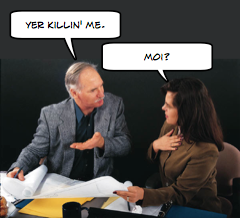I found a great question on LinkedIn the other day, and I thought I’d share my thoughts on it here.
The question was, “how do you tell a CEO that he/she is the problem when consulting to help solve ‘the problem’?”
It’s a very common issue, isn’t it? CEOs are people too, and therefore just as fallible as everyone else. The problem is, when a CEO or other senior executive is behaving counterproductively, and specifically creating problems for your organization, people often don’t know how to tell them. Because the CEO likely isn’t aware he or she is creating a problem, the problem persists, making life miserable for everyone else.
 I always believe in the direct approach, and have been known to tell the executive point blank, “you’re screwing up your company”. But that tends only to work in situations where a good relationship already exists. I likely wouldn’t take that approach or tone with an executive I didn’t know all that well. Also, while I might be less than shy about such things, many people are very shy, and worried about the ramifications of telling an executive senior to themselves something they might not want to hear.
I always believe in the direct approach, and have been known to tell the executive point blank, “you’re screwing up your company”. But that tends only to work in situations where a good relationship already exists. I likely wouldn’t take that approach or tone with an executive I didn’t know all that well. Also, while I might be less than shy about such things, many people are very shy, and worried about the ramifications of telling an executive senior to themselves something they might not want to hear.
To demonstrate the point, let’s use a specific example:
Let’s say you’re a project manager working for a CEO who insists on sitting in on every project review meeting and dominating every agenda item. The CEO believes he’s doing the right thing because he’s making sure his people know exactly what he wants. The problem is, work is slowing down because project team members have to stray from efficient courses of action to chase down things the CEO thinks he wants. Also, it’s a public show of diminished confidence. The results of the CEOs behaviour in this case may be a late project, or even a project that creates the wrong product or service! There will be morale impacts, too.
So what can you do?
Start by talking about the consequences. “Our project is running late and I don’t think we have a good handle on the end user requirements. We find ourselves wasting a lot of time.”
If your CEO has a pulse, that should immediately trigger the question, “why”. Here’s your opportunity to be fabulously diplomatic. Blurting out, “because you won’t leave us alone to do our jobs properly, you moron,” leads your executive to a conclusion they haven’t figured out for themselves. It’s insulting, too, even if you leave out the “you moron”. It’s not just insulting because it’s accusatory, it’s insulting because it accuses without providing supporting information. That’s frequently the problem with blame: it doesn’t connect the dots.
So spend time filling in the picture. “We’re running behind because we’ve been spending our time pursuing [insert annoying thing your CEO demanded in a recent meeting]. The plan our schedule is based off requires us to [insert good thing you probably should be doing].”
Likely the executive will recognize the assignment and try to justify it, but don’t let up. Assure them that the assignment is okay (after all it’s his or her show), but there are always consequences. Give another example, and quantify the consequences as much as you can.
Your executive will then likely retract any assignments he or she issued (“well geez I didn’t realize it’d be a problem“), but since your goal is to get them out of your meetings altogether, now’s the time for your coup de grâce. “Do you trust me,” you might ask. “If you do, perhaps you could let me run the meetings, and I could update you every week on everything that’s happening.” If they say yes, you win. If they say no, then you can have a candid discussion on trust, and why your executive doesn’t trust you. Even that’s a bonus, because it gives you an opportunity to air issues that you might not even be aware of (and you can address them head-on).
The gist of this approach is:
1) Begin the discussion with the consequences.
2) Lead your executive step-by-step back from the consequences through to the problem.
3) Let your executive identify the problem on his or her own.
4) Have a solution ready.
What I like about this approach is, it’s relatively non-confrontational, respectful, and eliminates accusations from the context of the discussion. You can keep dialogue with your executive open because you haven’t said anything that could put a wall up between you.
Do you have your own approach to dealing with problematic CEOs? Tell our readers in the comments section below!
Related articles
- Davos 2011: CEOs And Complexity – Forbes (blog) (blogs.forbes.com)
- CEOs Are Social Media No-Shows (blogs.forbes.com)
- CEO Education (professorbainbridge.com)
- Top 10 Challenges for CEOs in 2011 (dailyfinance.com)
- 5 Crash-Course Ways To Learn to Lead (edge.papercutpm.com)
- Five Great Articles about Trust (edge.papercutpm.com)

